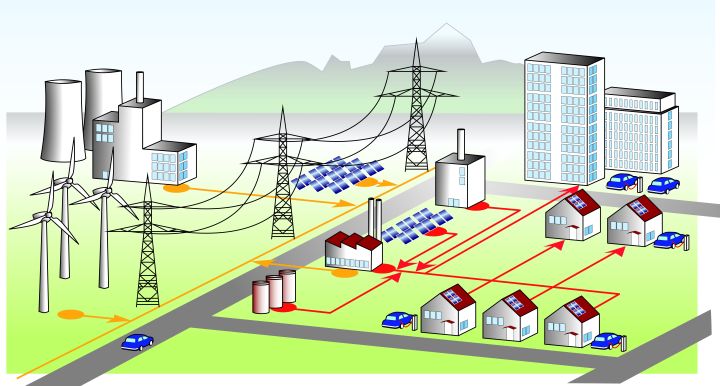
The German government has formulated clear targets for all areas of the energy transition. The energy supply is to be increasingly switched to renewable energies and used more efficiently. In addition to the focus on electricity generation, the sectors of heat and mobility towards renewable energies offer great potential. In order to analyze the interaction of the three sectors, adapted methods and tools are required. Fraunhofer IFAM has an extensive toolbox of models and simulation tools for analyzing different energy systems and scenarios and for developing sustainable energy supply systems. This is done both in public research projects and on behalf of energy supply companies or state authorities.
Energy turnaround in the quarter
In the course of the energy transition, the focus is shifting to energy supply and generation in the quarter. Electricity, heat and mobility requirements arise here, but there are also various potential energy sources. By looking at the quarter as a whole, synergies can be exploited and the upstream grids can be relieved. In addition, local potentials can also be included in the decarbonization of heat generation. The integral supply of a quarter requires the coordination of the interaction of generation, consumption and storage technologies. To support this process, Fraunhofer IFAM has tools for the simulation and visualization of heat networks. For different time series, it is possible to calculate how much heat is required to cover the heat demands and losses. The results then enable an optimal design of the energy systems in the quarter. By redesigning the energy supply of the quarter, not only the greenhouse gas reduction potential is tapped. The measures required in this context, such as refurbishment, conversion and new installation of technologies, also lead to positive value creation and employment effects in the region. The energy turnaround in the quarter thus contributes to the achievement of municipal goals: Climate protection, self-sufficiency and economic prosperity. To determine the regional economic effects, Fraunhofer IFAM has developed a tool which can be used to analyze the value creation and employment potential of the implemented technologies in different scenarios.
Energy sector coupling
By coupling different energy sectors (electricity with heat, gas and transport), fluctuating renewable energy can be better integrated and distributed across all sectors. The developed model "MuGriFlex" is used to simulate cross-sector energy systems, e.g. with electric boilers, heat pumps, storage units, CHP plants and electrolysers under different energy-economic framework conditions. The tool calculates an hourly optimized schedule for lowest heat supply costs or maximum system efficiency and determines plant combinations and sizes for the economically optimal supply. Special focus is placed on the influence and possible further developments of the framework conditions, such as investment subsidies or state-induced price components. In the joint project "Fahrplan Gaswende" (Gas Turnaround Roadmap), funded by the BMWi, this work is being intensified with a focus on climate protection in the gas and heating sector.
Electric vehicles support power grids
Digitization is becoming increasingly important in the automotive sector, especially in the area of electric vehicles. But electric vehicles can do more than just mobility: They can also be coupled with the electricity and heat sectors. As part of the BMWi project "i-rEzEPT," regenerative (V2G) electric vehicles are being used to stabilize or relieve the load on electricity grids. On the one hand, they participate in the primary control power market, and on the other hand, they serve as buffer storage in the building sector and temporarily store excess energy from local photovoltaic systems. The vehicles thus represent a quasi-stationary energy source as well as an energy sink at the same time. The aim of the research work at Fraunhofer IFAM is to digitally connect several vehicles and their charging infrastructure to existing energy management systems in buildings and power grids so that the energy services can be reliably provided.
Charging infrastructure for sustainable mobility
The expansion of electromobility is an important element of the transport turnaround. To this end, a sufficient number of low-emission or zero-emission vehicles must be brought onto the market. At the same time, however, the corresponding charging infrastructure must also be expanded rapidly. Only if drivers of electric vehicles can be sure that they will always find a good and reliable charging infrastructure will a rapid switch to electromobility succeed. The "Cities in Charge" project is therefore not only building charging infrastructure for e-vehicles, but also researching how the expansion of charging infrastructure can be accelerated. To this end, the project is investigating how the charging stations set up in the project are being used. Surveys of users of the charging infrastructure aim to find out how charging e-vehicles can be optimally integrated into everyday life. In addition, interviews with communes and cities will be used to analyze the specific obstacles and challenges encountered and which strategies have been particularly successful in planning and building new charging infrastructures. Furthermore, the contribution of the use of charging stations to the reduction of emissions will be investigated. For this purpose, a methodology was developed that can be used to calculate the reduction of NOx emissions through the use of e-vehicles for individual charging stations, charging networks of individual operators or for entire regions on the basis of data on charging processes.
 Fraunhofer Institute for Manufacturing Technology and Advanced Materials IFAM
Fraunhofer Institute for Manufacturing Technology and Advanced Materials IFAM